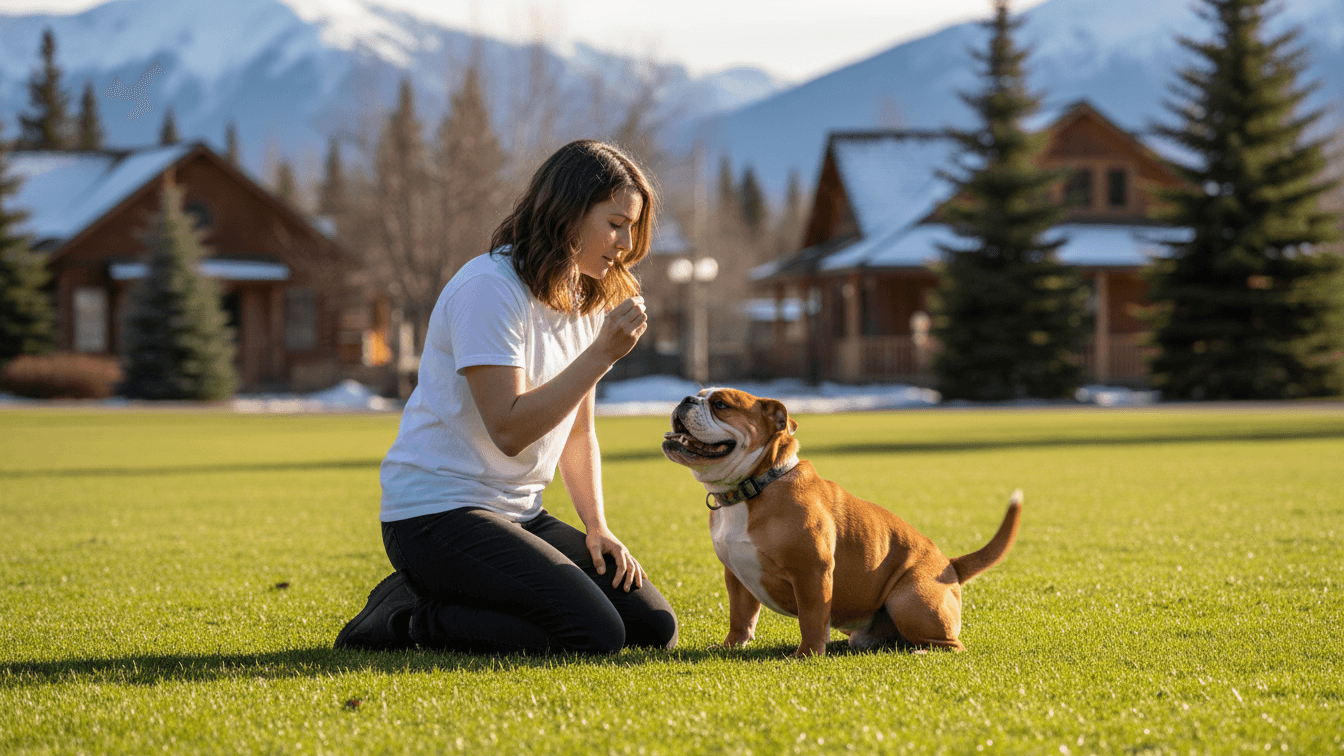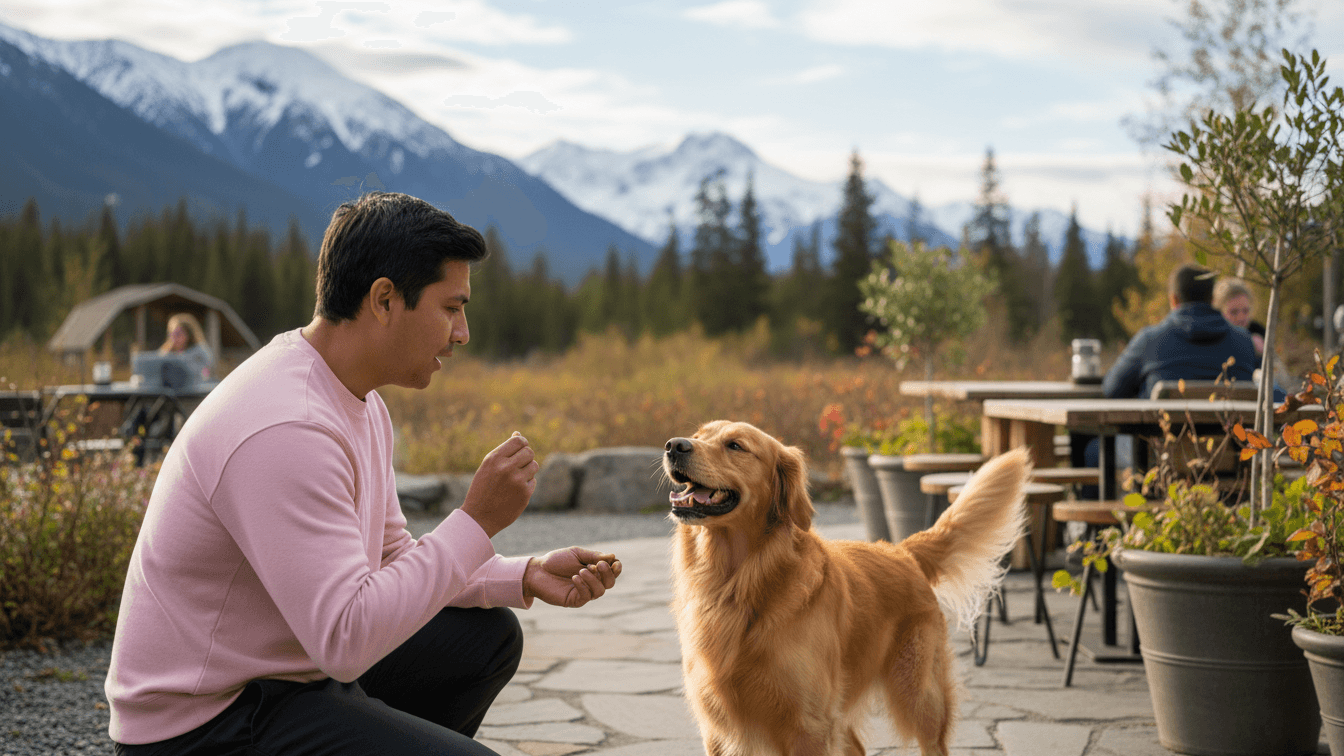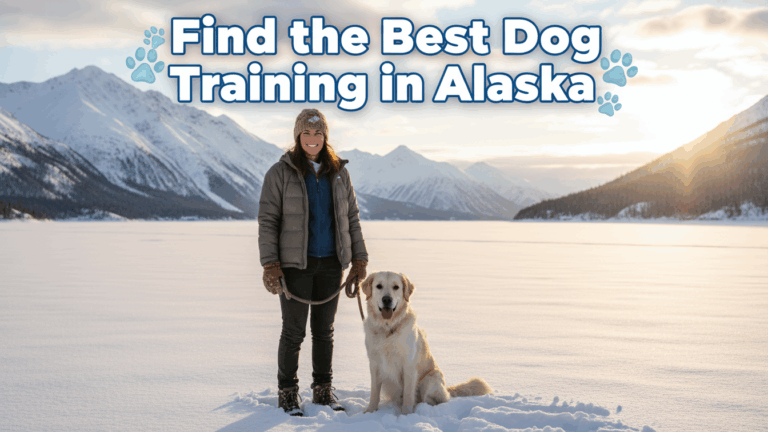Your Complete Guide to Choosing a Dog Trainer in Alaska and Surrounding Areas
Living with a dog in Alaska means preparing for unique challenges you won’t find anywhere else. Your dog needs to stay calm around moose in residential neighborhoods, handle winter darkness without developing anxiety, and remain under control when wildlife crosses your path on hiking trails. Alaska’s vast wilderness and sparse population create special training needs that generic programs can’t address.
Finding a qualified dog trainer in Alaska requires understanding both your dog’s needs and the realities of training in a state where local regulations vary widely by borough and municipality. Whether you’re in Anchorage, Fairbanks, Juneau, or one of Alaska’s smaller communities, the right trainer will help you build a well-behaved dog who thrives in Alaska’s unique environment.
How to Choose the Right Trainer
Start by looking for someone who uses positive reinforcement training and understands Alaska’s specific challenges. Your dog should learn to ignore wildlife distractions, stay calm during long winter months indoors, and handle the increased outdoor activity that comes with Alaska’s endless summer daylight.
Credentials give you a reliable way to compare trainers’ experience levels. Common dog trainer certifications include KPA-CTP, CPDT-KA, or IAABC-CDBC for behavior problems. If your dog shows serious aggression or fear issues, look for someone with CBCC-KA or a science-based program like CTC.
In-home dog training works especially well in Alaska since many behavioral issues happen at home during long winter months when outdoor time is limited. Private lessons let you focus on door manners when delivery drivers arrive, calm behavior when you’re gearing up for outdoor activities, and separation anxiety that can worsen during Alaska’s extreme seasons.
Group classes make sense once your dog can focus around other dogs, but check if the facility has indoor space for year-round training. Many Alaska trainers offer classes in warehouses, community centers, or indoor arenas to work around the state’s variable conditions.
Ask potential trainers how they handle Alaska-specific challenges like wildlife reactivity, winter exercise limitations, and the behavioral changes some dogs experience during extreme light changes. A professional dog trainer who has worked in Alaska will already have strategies for these common issues.
Common Dog Training Methods Explained

Reward-based methods build the trust and focus your dog needs to stay safe around Alaska’s wildlife and unpredictable conditions. These methods also help you maintain control without creating fear or aggression that could be dangerous in remote areas.
Basic obedience covers sit, down, stay, place, recall, and leash training so your dog can handle trail encounters, town visits, and emergency situations. A solid recall can literally save your dog’s life when a moose appears on your property or during off-leash hiking.
Puppy training focuses on socialization, potty training in extreme cold, bite control, crate comfort, and early leash skills. Starting young helps prevent problems before they develop, especially important when Alaska’s isolation can limit your access to training resources.
Behavior modification addresses fear, reactivity, resource guarding, or separation anxiety through careful desensitization and counterconditioning. Many Alaska dogs develop reactivity toward wildlife or anxiety during seasonal light changes, making this specialized work especially valuable.
Private lessons and in-home sessions let you customize everything around your daily routines and home environment. Day training can speed up results when you’re juggling work and limited daylight hours.
Dog training classes help your dog practice good manners around other dogs and people in a controlled setting. The best group classes give dogs plenty of space, screen participants carefully, and teach calm behavior rather than just excitement.
Specialized training like therapy dog training or service dog training requires extra structure, public-access skills, and a very clear step-by-step program. Alaska’s rural healthcare facilities and remote communities create unique opportunities for therapy dogs.
Stay away from trainers who use fear, intimidation, or pain to get results. These methods can create dangerous behavioral fallout, especially in a state where you need your dog to stay calm during genuinely stressful wildlife encounters.
Average Cost of Dog Training in Alaska (Updated for 2025)
Prices across Alaska tend to run higher than the lower 48 due to the state’s cost of living and limited competition in many areas. Travel fees can add significantly to costs in rural communities where trainers may drive considerable distances.
| Service Type | Average Cost (Alaska) |
|---|---|
| Puppy classes (4-6 weeks) | $200-$350 total |
| Group obedience classes (4-6 weeks) | $225-$400 total |
| Private lessons (60-90 min) | $125-$225 per session |
| In-home coaching packages (4-6 visits) | $550-$1,100 total |
| Day training (trainer works your dog) | $550-$1,200 per week |
| Behavior consult for reactivity/anxiety (initial) | $175-$300 |
| Board and train (2-4 weeks) | $2,500-$5,500 total |
Anchorage and Fairbanks typically see prices at the lower end of these ranges due to more competition, while Juneau, Ketchikan, and smaller communities often pay premium rates. Remote villages accessible only by plane may see even higher costs or limited access to professional trainers entirely.
Make sure you understand what’s included, how the trainer tracks progress, and whether they offer video coaching for follow-up sessions. Many Alaska trainers use video consultations to reduce travel costs for rural clients.
Questions to Ask a Potential Dog Trainer
- What training methods do you use, and how do you keep training sessions positive and low-stress?
- What credentials do you have, like CPDT-KSA or KPA-CTP? Do you keep up with continuing education?
- How do you address Alaska-specific challenges like wildlife reactivity, seasonal behavior changes, and limited outdoor training time in winter?
- Do you offer in-home visits, group classes, or day training, and which approach fits my goals best?
- How will we measure my dog’s progress and know when to add more distractions?
- What are the total costs, including any travel fees, and what’s your cancellation policy?
- Do you carry liability insurance, and can you show me proof?
- For behavior problems, will you work with my veterinarian if needed?
- Can you provide references from other Alaska dog owners you’ve worked with?
- What should I practice between our sessions to help my dog keep improving?
Local Alaska Rules and Considerations
Alaska’s dog laws vary significantly by municipality and borough, so research the specific rules for your community. Most populated areas enforce leash laws and nuisance ordinances, but enforcement and specifics differ widely.
Anchorage requires dogs to be leashed in most public areas except designated off-leash zones. The city also requires current rabies vaccination and a municipal dog license renewed annually. You can find details through the Anchorage Animal Care and Control website.
Fairbanks North Star Borough enforces leash laws in most areas and requires rabies vaccination. The borough also has specific regulations about tethering dogs outside, with requirements for adequate shelter and humane restraint methods.
Juneau requires leashes in most public spaces and maintains strict rules about dogs running at large. The city also enforces nuisance barking ordinances, so work with your trainer on alert barking and separation anxiety before neighbors complain.
Alaska state law requires current rabies vaccination for all dogs over four months old. Your veterinarian must provide proof of vaccination, and you should carry this documentation when traveling with your dog.
Many Alaska communities have specific ordinances about dogs and wildlife interactions. Some areas prohibit dogs on certain trails during specific seasons to protect wildlife, while others require extra control measures in areas with frequent moose activity.
Alaska does not require special licenses for dog trainers at the state level. Individual municipalities may require business licenses for anyone operating a training business, and facilities that board dogs typically need to meet basic health and safety standards.
The Alaska Department of Fish and Game provides guidelines about dogs and wildlife interactions, which becomes important for anyone hiking or living in areas with bears, moose, or other wildlife.
Local Alaska Resources for Dog Owners
These locations give you great places to practice obedience training, work on socialization, and provide safe enrichment for your dog. Always follow posted rules and stay aware of your surroundings for wildlife.
In Anchorage:
- University Lake Dog Park offers a fully fenced off-leash area where you can practice recalls and calm greetings during quieter times
- Conners Bog Off-Leash Dog Park provides trails and open space for training around distractions in a controlled environment
- Far North Bicentennial Park allows leashed dogs on many trails, giving you perfect opportunities to build focus around other trail users and occasional wildlife
In Fairbanks:
- Growden Memorial Park includes areas suitable for leashed training walks where you can work on loose-leash skills
- Chena River State Recreation Area welcomes leashed dogs on trails, providing excellent real-world training opportunities
In Juneau:
- Twin Lakes Park welcomes leashed dogs and offers good trail options for building your dog’s focus and endurance
- Eaglecrest Ski Area allows leashed dogs on many trails during summer months when lifts aren’t running
Many Alaska communities also have informal areas where locals exercise their dogs, but always verify current rules before using these spaces for training for dogs.

FAQs
How much does in-home dog training cost?
Most Alaska trainers charge $125-$225 per in-home visit, with packages typically offering modest discounts. Behavior problems usually start at the higher end of that range. Add travel fees if you live outside the trainer’s primary service area, especially in rural communities.
Is in-home dog training worth it?
Absolutely, especially in Alaska where home-based behavioral issues are common during long winters. Your trainer can address door manners, jumping on guests wearing heavy gear, counter-surfing, and window reactivity toward wildlife right where these problems happen. Then you can step outside to practice leash skills on your actual property and neighborhood.
Can you pay someone to house train your dog?
Yes, many trainers offer puppy training programs that include potty training, crate routines, and daily schedules. Day training can speed up the process while teaching you how to maintain progress. This becomes especially valuable in Alaska where potty training in extreme cold requires specific strategies.
What is the 3-3-3 rule for dog training?
This helpful timeline applies to new or adopted dogs: expect about 3 days for your dog to decompress, 3 weeks to learn your routines, and 3 months to feel completely settled. Good training programs work with this natural adjustment period rather than rushing the process.
How long will it take to reach my training goals?
Most puppies and friendly adult dogs show solid progress within 4-8 weeks if you practice daily. Fear, reactivity toward wildlife, or aggression typically requires several months of careful behavior modification with gradual increases in difficulty. Alaska’s seasonal changes may affect your timeline, with some dogs progressing faster during summer months when outdoor training is easier.
What should I bring to group classes?
Pack a flat collar or harness, a 6-foot leash, high-value treats that won’t freeze if you’re training in cold weather, water, and current vaccination records if your trainer requests them. Leave retractable leashes at home for safety reasons. In winter, bring gear to keep yourself comfortable since indoor training facilities can vary in temperature.
What’s the leash law in Alaska?
Leash laws vary by municipality. Anchorage requires leashes in most public areas except designated dog parks. Fairbanks North Star Borough enforces similar leash requirements. Juneau maintains strict leash laws in most public spaces. Check your specific community’s municipal code for exact requirements, as rural areas may have different or less formal regulations.
Do I need a dog license in Alaska?
Requirements vary by municipality. Anchorage requires annual dog licenses available through Anchorage Animal Care and Control. Fairbanks North Star Borough has its own licensing requirements. Juneau also requires dog licenses for residents. Many smaller communities don’t require licenses but still mandate rabies vaccination.
What shots does my dog need in Alaska?
Alaska state law requires rabies vaccination for all dogs over four months old. Your veterinarian will also likely recommend distemper-parvo combination vaccines. Dogs attending group classes or day training often need bordetella (kennel cough) vaccination as well. Discuss your dog’s lifestyle with your vet to determine the full vaccination schedule.
Are dog trainers required to be licensed in Alaska?
Alaska does not require special licenses or certifications for dog trainers at the state level. Trainers follow normal business regulations for their municipality, and facilities that board dogs may need to meet local health and safety standards. Look for voluntary certifications to verify a trainer’s education and commitment to professional standards.
Where can I practice off-leash recall?
Use designated off-leash dog parks like University Lake Dog Park or Conners Bog Off-Leash Dog Park in Anchorage for safe, legal practice. Some areas of state recreation lands allow off-leash activity, but verify current regulations before letting your dog loose. Always start recall practice in fenced areas before progressing to unfenced spaces.
Which dog parks allow training around Alaska?
University Lake Dog Park in Anchorage welcomes training practice within its fenced boundaries. Conners Bog Off-Leash Dog Park also provides good space for working on obedience and socialization skills. Visit during off-peak hours when you’re starting out to reduce distractions and help your dog succeed.
What trails allow dogs for training?
Far North Bicentennial Park in Anchorage allows leashed dogs on many trails, perfect for building focus around other trail users and wildlife. Chena River State Recreation Area near Fairbanks welcomes leashed dogs and offers varied terrain for training walks. In Juneau, Twin Lakes Park provides good trail options for leashed training. Always check current regulations before visiting, as some trails restrict dogs seasonally to protect wildlife.
How do I handle my dog around Alaska wildlife?
Work with a professional dog trainer experienced in wildlife reactivity to teach your dog a solid emergency recall and calm response to wildlife sightings. Never allow your dog to chase or approach wildlife, as this is dangerous for your dog and illegal in many situations. Practice impulse control exercises regularly so your dog can resist the temptation to chase even when startled by a moose or other animal.
What if my dog develops winter behavior problems?
Many Alaska dogs struggle with reduced exercise, increased indoor time, and extreme light changes during winter months. Work with a trainer on mental enrichment activities, indoor training games, and strategies to maintain your dog’s training program year-round. Separation anxiety and destructive behaviors often worsen in winter, making proactive training especially important.
The right combination of humane training methods, Alaska-specific strategies, and consistent practice will help your dog become a confident, well-behaved companion no matter what challenges Alaska throws your way. Whether you choose group classes, private lessons, or in-home training, finding an expert dog trainer who understands life in Alaska makes all the difference in creating lasting results.
